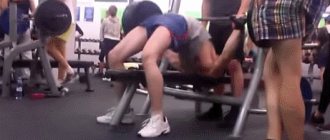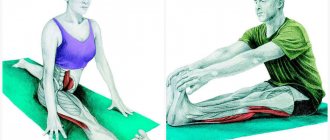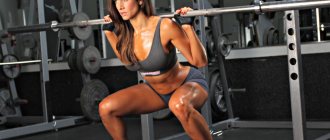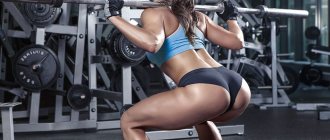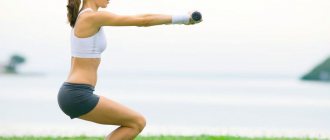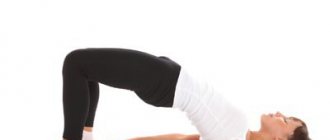If you train hard, eat right, but still can’t achieve an increase in buttock size, you don’t need to give up on your goal. Use these recommendations.
It often happens that a person trains hard, follows all the rules and recommendations on how to pump up his butt, but still cannot achieve the ideal rear view. If you see that your thighs have become more toned, your abdominal muscles have become stronger, but there are no changes in your buttocks, then you are in one of these problematic situations.
Sleeping butt syndrome
The funny name hides a real problem; it is quite common among modern people. A sedentary lifestyle, sedentary work, rare walks, the habit of resting in a lying or sitting position act as factors for the development of sleeping buttock syndrome. Getting used to this lifestyle, the body tends to transfer the load from the buttocks to other muscle groups; when performing squats, it forces the knees to fall inward or pulls the pelvis to the side, as a result, the necessary muscles do not receive enough load.
Sleeping butt syndrome is easier to prevent, but getting rid of it is also quite possible. You need to concentrate your training around isolated exercises that involve the hip joint, such as leg circles, abductions and adductions. The exercises should be performed first in a lying position, then on all fours, and later switch to training in a standing position. Start by doing static exercises, keeping your muscles tense for a few seconds, then move on to dynamic exercises, using weights.
The main task is to concentrate on your sensations and feel that the load is on the buttocks.
Neutral spine position
It is very important to do almost any exercise while maintaining a neutral position of the spine (this is one of the nuances of the correct exercise technique). It is needed to evenly load the entire spine, eliminating potential health risks, increasing the level of intensity with a stable skeleton.
Stand with your back to the wall, press your heels, shins, pelvis, shoulder blades, and the back of your head against the wall. Place 2 palms together under your lower back and press your lower back against the wall. This is your neutral spine position to maintain during many exercises! This is probably your correct posture.
Now we take a stick and place it behind our back along the spine. The stick touches the sacrum, the area of the shoulder blades and the back of the head. In this position, you can learn to do bends, squats, and hyperextensions.
Insufficient load on the muscles
Perhaps you feel sorry for yourself or have not yet learned how to distribute loads correctly, but the result is the same - the muscles do not work the way they should. If you feel like your knees and hips are too tired when doing squats, then you're not squatting correctly. A burning sensation and moderate pain should appear in the trained area; if the knees and hips hurt, it means that the load is on them.
When performing exercises such as deadlifts, squats and lunges, many muscle groups are loaded, in this situation it is quite difficult to understand which muscles are working at the moment. But this is not a reason to refuse basic exercises in favor of isolated ones; both should be present in the training program. After training, a burning sensation should be felt specifically in the gluteal muscles; it will indicate that the session was not in vain.
Additional exercises (which can be included if glute growth is poor)
I. Gluteal bridge.
I recommend doing it before essential exercises to lightly fatigue your glutes and subsequently load them more.
Exercise technique
1.
There are many nuances of the technique, the main thing here is to understand that you don’t need a lot of weight, which will still fall on your knees and spine, and not on your buttocks!
2.
The range of contraction of the buttocks here is small, so the exercise is only additional to fatigue the buttocks and their possible activation (in case of hypotonicity).
3.
If you have a stooped, round, round-concave posture, and especially with kyphosis, you cannot do a gluteal bridge across the bench! There may be problems with the spine, especially the cervical region. Replace the bench with a large fitball, or a floor where your head is not suspended and does not tilt back.
II. Leg press with high feet.
It is preferable to do the leg press while sitting rather than lying down at an incline. It works the gluteal muscles well if the technique is correct. You can focus on white muscle fibers (10-15 repetitions) with high intensity, with little fear of enlarging your thighs.
Exercise technique
1.
Place your feet higher, but in such a way that it is comfortable to work. The feet are slightly wider than the shoulders and slightly turned outward. The emphasis can be shifted slightly to the heels; there is no need to tear off the toes.
2.
The sacrum and lower back are always pressed against the back and do not round when the platform is lowered towards you.
3.
A common mistake of exercisers, performing bikini athletes and “gurus” trainers is that they believe that this position of the feet allows them to work the hamstrings, judging purely by sensations. In fact, this is a misconception that results in an unbalanced load on the front and back of the thigh. The back surface of the thigh, when pressing the platform, almost does not change its length, stabilizing the joint, which causes sensations. Whatever one may say, the buttocks, adductors and the anterior surface of the thigh work here, differing in different load distributions.
4.
The head should rest on the backrest or headrest. This is often a problem with the simulators themselves.
Monotony of training
At the very beginning of training, 50 squats a day will be a sufficient load, under its influence the muscles will tighten up a little. But if you constantly train according to the same program, your progress will stop. All muscles have the ability to adapt to loads, especially large and strong muscles like the glutes. To increase the load, change the number of repetitions and approaches, and connect power equipment for weighting.
It is important to modify the basic exercises, instead of regular lunges, use dynamic lunges with steps, change the barbell to a kettlebell, make changes to the work mode - conduct training more slowly or quickly, include static and dynamic exercises.
Exercise “Squat with a barbell”
We start the lesson with a squat with a barbell. This is a basic exercise that has a number of important nuances.
The first nuance: the position of the elbow. Place your palms shoulder-width apart, lower the bar below the seventh vertebra and bring your elbows forward. We focus your attention on ensuring that the elbows always remain along the body, otherwise when they go too far back, this provokes a strong deflection of the lower back.
The second nuance is a strong deflection in the lower back. In order to correct it, you need to twist your pelvis and lower yourself down with a straight back and collected abs.
The third nuance is the correct position of the knees during the exercise. The distance between the knees remains equal to the distance between the feet. The main mistake is bringing the knees inward. We spread our knees outward, transfer our body weight to the heel and stand up.
And so, observing all the nuances, we try to squat. We remember about the palm and the position of the elbow, take a step back, twist the pelvis. The distance between the knees is equal to the feet.
Poor nutrition
The human body is one, therefore, to improve one part of the body, balance is required in the entire biological system. Typically, poor nutrition is two extremes, when a person rewards himself for training with unhealthy high-calorie foods and cannot see his muscles under a layer of fat, or when a strict diet is used and the muscles do not receive the necessary amount of nutrients for growth. Not only body weight, but also skin elasticity depends on nutrition; the predominance of processed foods and preservatives in the menu affects the hips, the condition of the skin worsens, and cellulite appears in women.
Exercise "Deadlift"
We will do this exercise with dumbbells. The main nuances are similar to the nuances of the technique of performing squats with a barbell: we bring the shoulder blades together, twist the pelvis, and make the neck an extension of the spine. The movement occurs in the hip joint, we lower ourselves slowly down, the back is straight, without bending we return to the starting position. Frequent mistakes are a raised chin, arched lower back and far away dumbbells. We correct it from the hip, twist the dumbbells, lower the pelvis, lower the neck as a continuation of the spine and rise up.
Improper exercise
Any exercise will only work if it is performed with the correct technique. Even an incorrect range of motion or irregular breathing can prevent muscles from growing. Incorrect body position helps to remove the load from the right muscles. In order to establish the correct technique, you need to conduct several lessons with a professional trainer.
Hello! Today there will be an article on a sports topic. How to quickly pump up your buttocks? How long does it take to pump up your buttocks? What are the most effective exercises for shaping your gluteal muscles? Today I'll cover a variety of these questions and more, giving you lots of PRACTICAL advice on the topic.
The anatomy of the buttocks is a very important issue, because... we need to know how muscles work in order to pump them up as quickly and efficiently as possible.
Buttock muscles
- belong to the muscles of the back of the thigh and are involved in straightening the torso, as well as moving the legs back and to the side.
As can be seen from the picture, almost the entire volume of the buttocks is occupied by the LARGE GUTTEUS MUSCLE (lat. gluteus maximus). Therefore, its appearance will largely depend on its shape.
Functions of the gluteus maximus muscle:
- Straighten your torso.
- Move your leg BACK.
MEDIUM (lat. gluteus medius) + SMALL (lat. gluteus minimus) gluteal muscles are located in the upper part of the buttocks and are almost completely covered by the gluteus maximus muscle.
Functions of the gluteus medius and minimus muscles:
- Move your leg TO THE SIDE.
That's all anatomy, friends. As you can see, everything is simple. Now let's talk about how long it takes to pump up your gluteal muscles.
And the process of developing the gluteal muscles is not very different from pumping up the muscles of the rest of the body and is subject to the same rules of growth as all muscles, namely:
- PROGRESSION OF LOAD
(the volume of training should increase). Perhaps the main rule, because THERE IS NO SENSE FOR MUSCLES TO INCREASE IF THE LOAD DOES NOT INCREASE. - NECESSARY RECOVERY
(small meals 6-12 times a day + sleep 8-10 hours).
(you need to learn what you want to develop).
That's all. The more scrupulously you follow these rules, the faster you can pump up your buttocks. It's not as difficult as it seems.
The gluteal muscles respond quite quickly to the load, because... contain a fairly large number of mixed muscle fibers, which means growth will occur in almost any repetition range.
The butt doesn't wobble. Butt doesn't grow
- Lack of progression of loads = without this, muscle growth (in this case, buttocks) is impossible
- Incorrect exercise technique (in this case, on the buttocks)
- Incorrect exercises, and in general, buttock training = as a result of lack of effective growth
- COMBO (reasons No. 1 and No. 2 are very often INTERRELATED), in pursuit of weight (progression of the load), girls can violate the technique of performing one or another exercise, as a result, you do not engage the gluteal muscles well enough in the exercise, you do not feel the working muscle well and, accordingly, , the buttocks contract poorly (or ineffectively) because of this they do not grow)
- Lack of mental connection between brain and muscle (in this case, brain and buttocks) (this is the same as I said above, i.e. you don’t feel the working muscle well, in this case, buttocks = result = buttocks contract poorly (ineffective).
- Too infrequent training on the buttocks (resulting in poor growth, minimal or no growth at all...)
- You are on a diet to lose weight (you eat little, you have a kcal deficit, respectively, in this situation = muscles (in this case, buttocks) cannot a priori grow, even if you go to the gym and work there with weights, do exercises and etc.
- No excess calories = therefore, no muscle growth (in this case, buttocks)
- Genetic data. Many girls are very often impressed by other girls, their chic forms, and accordingly, they want themselves to be the same as theirs. However, this is not always possible. We are all different, we all have different genetic data. Understand? Maybe you are not as lucky with genetics as the other girl, and your muscle growth (development) is minimal.
- Lots of cardio (aerobic training) that interferes with the growth of the gluteal muscles.
- Lack of quality recovery = as a consequence = growth of (gluteal) muscles.
What mistakes are most often made when working with the buttocks?
Many people think the more repetitions or workouts per week, the better. This position can simply turn off the muscle: during training it gets real stress, and if you don’t give it rest, it won’t do any good.
They often stick their buttocks out backwards, which is simply murder for the spine. You squat like this for a couple of years - and hello, hernias and protrusions.
Another situation is when your trainer only believes in the Holy Squat, but you don't feel your glutes engaging. And he responded - because the technique is bad or the weight is too small, let’s throw it on. The risk of injury increases rapidly.
The gluteal muscles perform 3 functions: extension of the hip joint, abduction of the leg to the side and external rotation of the hip. Therefore, the load must be applied in all three planes, and not just in squats and lunges in the sagittal plane.
